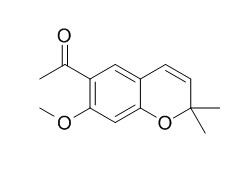Encecalin
Encecalin and demethylencecalin are major phytotoxic compounds isolated from Helianthella quinquenervis (Hook) A Gray (Asteraceae), they inhibit photosystem II (from water to 2,5-dibromo-3-methyl-6-isopropyl-1,4 p-benzo-quinone).They retard seed germination and reduce radicle and hypocotyl growth of weed and crop plant seedlings.
Inquire / Order:
manager@chemfaces.com
Technical Inquiries:
service@chemfaces.com
Tel:
+86-27-84237783
Fax:
+86-27-84254680
Address:
1 Building, No. 83, CheCheng Rd., Wuhan Economic and Technological Development Zone, Wuhan, Hubei 430056, PRC
Providing storage is as stated on the product vial and the vial is kept tightly sealed, the product can be stored for up to
24 months(2-8C).
Wherever possible, you should prepare and use solutions on the same day. However, if you need to make up stock solutions in advance, we recommend that you store the solution as aliquots in tightly sealed vials at -20C. Generally, these will be useable for up to two weeks. Before use, and prior to opening the vial we recommend that you allow your product to equilibrate to room temperature for at least 1 hour.
Need more advice on solubility, usage and handling? Please email to: service@chemfaces.com
The packaging of the product may have turned upside down during transportation, resulting in the natural compounds adhering to the neck or cap of the vial. take the vial out of its packaging and gently shake to let the compounds fall to the bottom of the vial. for liquid products, centrifuge at 200-500 RPM to gather the liquid at the bottom of the vial. try to avoid loss or contamination during handling.
Molecules.2024, 29(5):1171.
Plant Biotechnology Reports 2021, 15:117-124.
Int J Mol Sci.2021, 22(19):10220.
J Chromatogr B Analyt Technol Biomed Life Sci.2019, 1113:1-13
Chin Med.2022, 17(1):66.
Food Sci Biotechnol.2024, 34(3):611-620.
The Korea Journal of Herbology2020, 35(3):33-45.
Am J Chin Med.2016, 44(8):1719-1735
Antioxidants (Basel).2021, 10(8):1300.
Aging (Albany NY).2021, 13(19):22867-22882.
Related and Featured Products
J Chem Ecol. 1989 Jul;15(7):2073-87.
Eupatoriochromene and encecalin, plant growth regulators from yellow starthistle (Centaurea solstitialis L.).[Pubmed:
24272297]
METHODS AND RESULTS:
Two chromenes, eupatoriochromene (1) and Encecalin (2), have been isolated from yellow starthistle (Centaurea solstitialis L.). Both chromenes retard seed germination and reduce radicle and hypocotyl growth of weed and crop plant seedlings. In addition,1 increases adventitious root formation of mung bean cuttings.
J Chem Ecol. 1996 Mar;22(3):491-8.
Fate of the chromene encecalin in the interaction ofEncelia farinosa and its specialized herbivoreTrirhabda geminata.[Pubmed:
24227488]
METHODS AND RESULTS:
Leaf beetles of the speciesTrirhabda geminata are specialized herbivores that are able to feed on the chemically well-protected foliage of the desert sunflowerEncelia farinosa, which contains the insecticidal chromene derivative Encecalin. Chemical analysis of the beetles and their fecal excretions indicated that Encecalin is present only in the alimentary canal and is not absorbed across the gut membrane, as previously shown for other herbivorous insects (e.g., the Egyptian armyworm,Spodoptera littoralis) that are susceptible to this chromene derivative. Further differences betweenT. geminata and nonadapted insects were observed with regard to the metabolism of Encecalin. Whereas the Encecalin-resistent leaf beetles metabolize Encecalin mainly to encecalol by reduction of the acetyl group, susceptible insects, such as larvae ofS. littoralis, metabolize Encecalin mainly by exoxidation of the 3,4 double bond, which creates a powerful alkylating agent and is responsible for the toxicity of Encecalin.
CONCLUSIONS:
Reductive rather than oxidative metabolism of Encecalin therefore seems important for the resistance ofT. geminata against the chemical defense of their host plantE. farinosa.
Journal of the Science of Food & Agriculture, 1998,78(1):102-8.
Effect of encecalin, euparin and demethylencecalin on thylakoid electron transport and photophosphorylation in isolated spinach chloroplasts.[Reference:
WebLink]
The major phytotoxic compounds (Encecalin, euparin and demethylEncecalin) isolated from Helianthella quinquenervis (Hook) A Gray (Asteraceae) were evaluated on different photosynthetic activities in chloroplasts isolated from spinach leaves.
METHODS AND RESULTS:
ATP synthesis, proton uptake and electron flow (basal, phosphorylating and uncoupled) were inhibited by Encecalin and demethylEncecalin in a concentration dependent manner, therefore acting as Hill reaction inhibitors. Encecalin and demethylEncecalin did not affect photosystem I (electron transport from diaminodurene to methylviologen), but they inhibited photosystem II (from water to 2,5-dibromo-3-methyl-6-isopropyl-1,4 p-benzo-quinone). Since these compounds inhibited electron flow in the photosystem II partial reactions from water to silicomolybdate and from diphenylcarbazide to dichlorophenol-indophenol, the site of inhibition was located in the span from P 680 to QA of the electron transport chain. Euparin, inhibited ATP synthesis, proton uptake and basal and phosphorylating electron transports, but it has not effect on uncoupled electron flow from water to methylviologen. Mg2+-ATPase activity from bound membrane thylakoid chloroplasts was also inhibited by this compound.
CONCLUSIONS:
These results suggested that euparin inhibited phosphorylation in chloroplasts, acting as an energy-transfer inhibitor.



